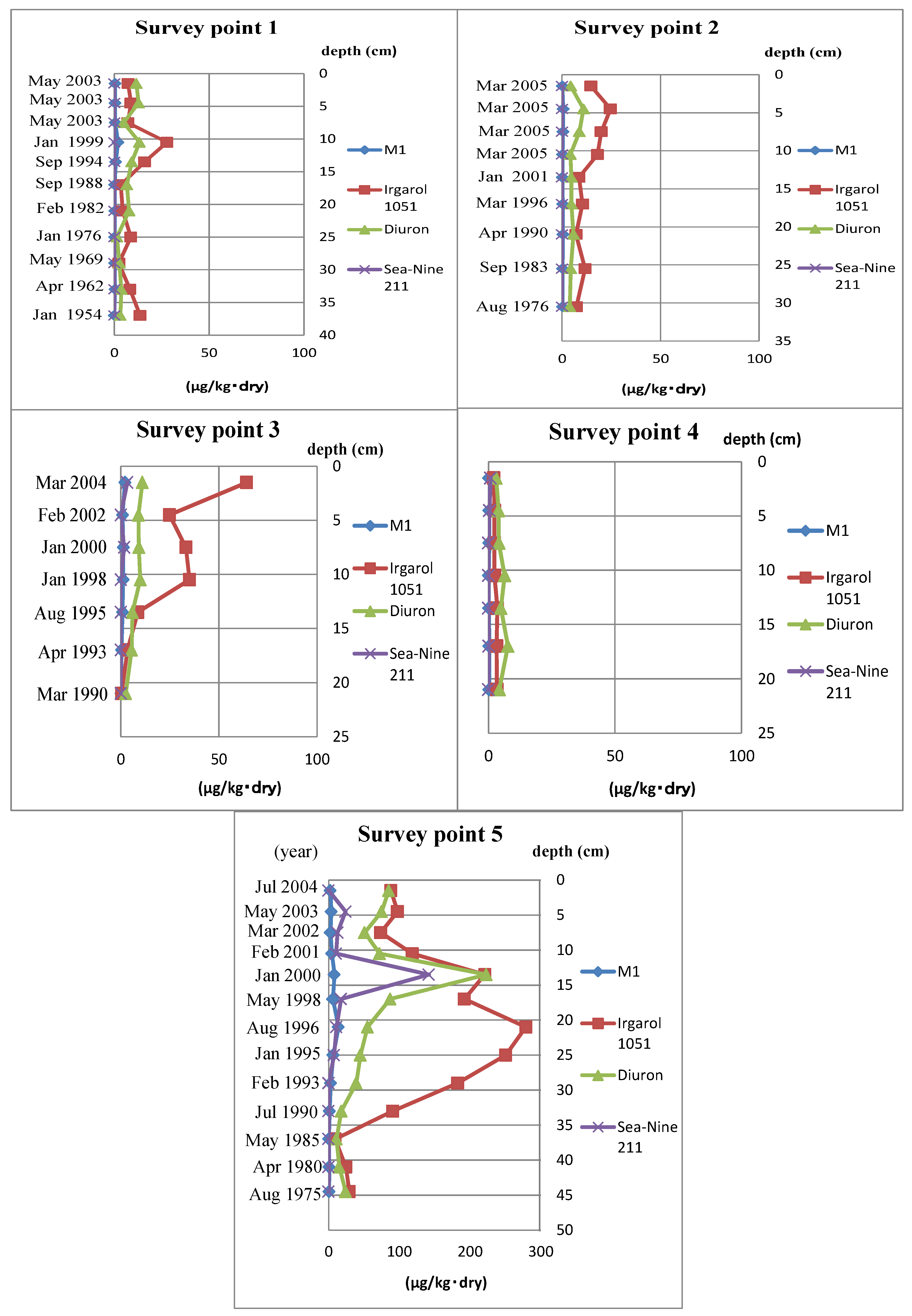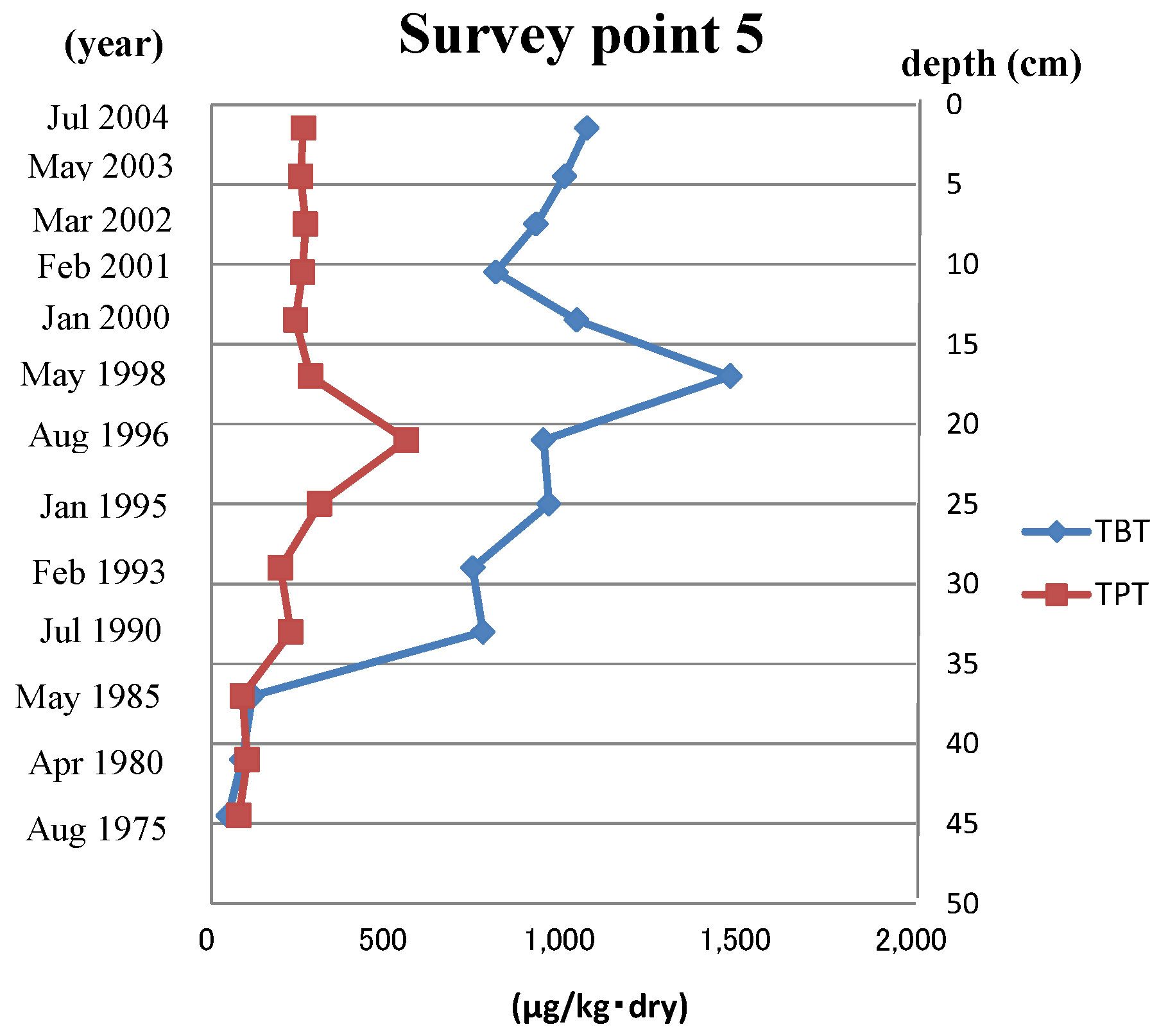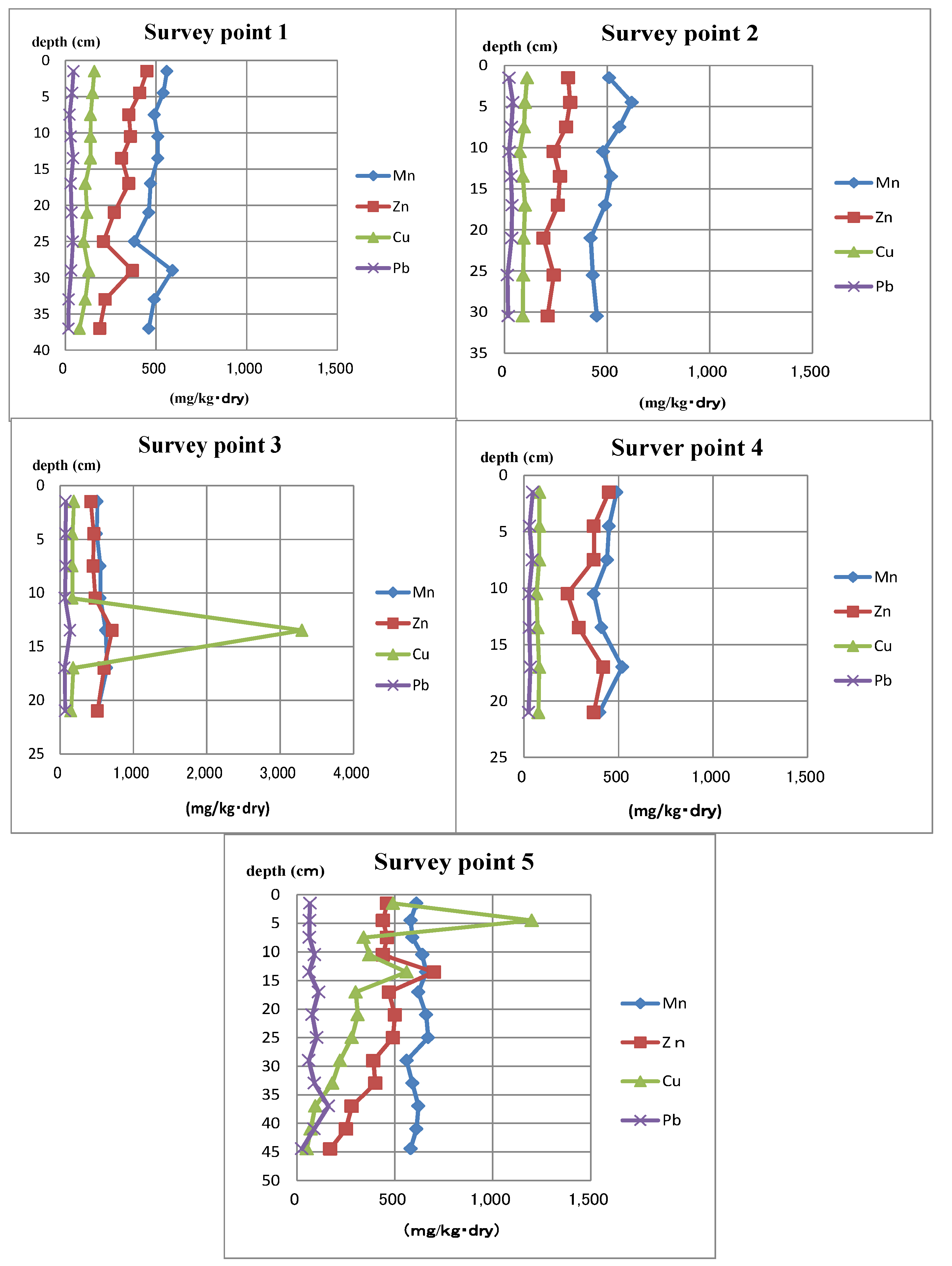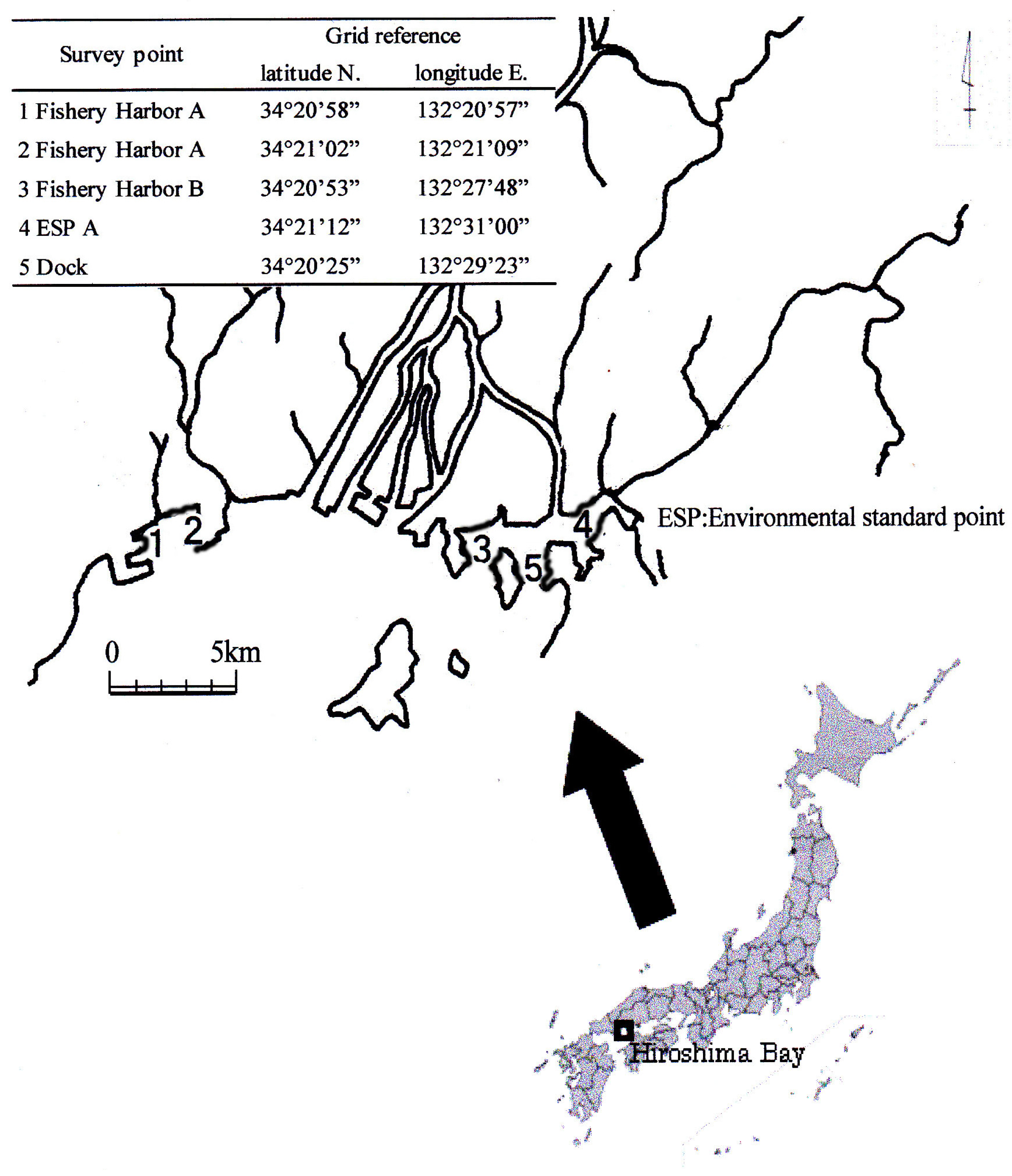Concentration of Antifouling Biocides and Metals in Sediment Core Samples in the Northern Part of Hiroshima Bay
Abstract
:1. Introduction
2. Results
2.1. Alternative Biocides
| Point Number | Irgarol 1051 | M1 | Diuron | Sea-Nine 211 |
|---|---|---|---|---|
| 1 | 2.4–27 | ND–0.8 | 1.4–13 | ND |
| 2 | 7.1–24 | 0.2–0.5 | 3.9–10 | ND |
| 3 | 0.4–64 | 0.1–2.1 | 2.5–11 | ND–3.3 |
| 4 | 2.1–3.5 | 0.1–0.3 | 3.0–7.7 | ND–0.8 |
| 5 | 9.1–270 | 0.4–13 | 11–220 | 7.6–140 |

| Location | Concentrations (µg/kg) | Reference | |||
|---|---|---|---|---|---|
| Irgarol 1051 | M1 | Diuron | Sea-Nine 211 | ||
| Hiroshima Bay, Japan (2004, 2005) | 0.4–270 | <0.1–13 | 1.4–220 | <1.0–140 | this research |
| Hiroshima Bay, Japan (2002–2005) | <1–28 | <1–9 | <4–73 | *** | [25] |
| Otsuchi Bay, Japan (2005) | <0.05–100 | <0.18–0.47 | <0.08–530 | <0.04–150 | [22] |
| Osaka Bay, Japan (2003) | <0.08–8.2 | <0.18–2.9 | <0.64–1350 | <0.04–2.4 | [24] |
| Piraeus-Elefsina, Greece (1999, 2000) | <LOD–690 | *** | *** | <LOD–49 | [20] |
| Southampton Water, UK (2000) | 0.3–3.5 | <LOD–0.3 | 0.4–6.2 | *** | [15] |
| Barcelona, Spain | 3–57 | 0.2–3.3 | *** | *** | [23] |
| Southampton Water, UK (1998) | <LOD–110 | *** | <LOD–1420 | *** | [16] |
| Baltic Sea (1997, 1998) | <4–220 | *** | *** | *** | [21] |
| North Sea (1997, 1998) | <LOD–14 | *** | *** | *** | [21] |
| Orwell Estuary, UK (1998) | <10–1011 | *** | <12–395 | *** | [17] |
| The Solent, UK (1998) | <LOD | <LOD–5.7 | <LOD | *** | [26] |
| Blackwater Estuary, UK (1998, 1999) | 3.3–222 | *** | *** | *** | [18] |
| Hamble Estuary, UK | 12–190 | *** | *** | *** | [19] |
2.2. Organotin Compounds

2.3. Metals
| Point Number | Pb | Cu | Zn | Fe | Mn |
|---|---|---|---|---|---|
| 1 | 17–45 | 78–160 | 190–450 | 36,000–50,000 | 380–590 |
| 2 | 14–41 | 74–110 | 190–320 | 37,000–46,000 | 430–620 |
| 3 | 62–140 | 150–3300 | 420–710 | 60,000–82,000 | 500–640 |
| 4 | 25–47 | 67–82 | 230–450 | 48,000–60,000 | 370–520 |
| 5 | 25–160 | 50–1200 | 170–700 | 41,000–45,000 | 560–670 |

3. Discussion
| Survey Point | Specific Surface Area (cm2/cm3) | Median Particle Size (µm) | Arithmetic Mean Particle Size (µm) | Below 67 µm (%) |
|---|---|---|---|---|
| 1 | 33,926 | 10.1930 | 15.0119 | 97.5 |
| 2 | 24,890 | 14.4307 | 33.6879 | 86.0 |
| 3 | 33,374 | 10.1875 | 19.3025 | 93.4 |
| 4 | 37,229 | 8.9690 | 15.4780 | 95.7 |
| 5 | 40,214 | 7.6898 | 12.1456 | 98.1 |
4. Experimental Section
4.1. Sampling Description
4.1.1. Sampling
4.1.2. Chemicals

4.2. Chemical Analysis
4.2.1. Alternative Biocides
4.2.2. Organotin Compounds
| Conditions | |
|---|---|
| LC | Agilent model 1100 series HPLC (Agilent; Yokogawa Analytical System, Tokyo, Japan) |
| Column | narrow bore C18 silica column (2.1 mm i.d. × 150 mm, 5 μm) TSKgel ODS-80T (TOSOH) |
| Mobile phase | (A):(B) 50:50 → (20 min) → 100:0 (10 min) (A): methanol; (B): water |
| Flow rate | 20 µL/min |
| Oven temp. | 40 °C |
| Injection vol. | 10 µL |
| MS | PE-Sciex API2000 (Sciex; Applied Biosystems, Framingham, MA, USA) |
| Analytical mode | ESI-MS-MS |
| Ionization | positive ion mode |
| Nitrogen curten gas | 40 µL/min |
| Ion spray voltage | 4800 V |
| Ion source gas 1 | 40 µL/min |
| Ion source gas 2 | 70 µL/min |
| Collision gas | 4 µL/min |
| Monitor ions | Sea-Nine 211: 282/170(43) Diuron: 233/46(160) Irgarol 1051: 254/198(83) M1: 214/158(43) |
| Conditions | |
|---|---|
| GC | Hewlett-Packard 6890 Series GC System |
| Column | DB-5ms (0.25mm i.d. × 30m, 0.25 μm) (J&W Scientific Co., Folsom, CA, USA) |
| Oven temp. | 60 °C (2 min)—raised by 20 °C/min—130 °C—raised by 10 °C/min—210 °C—raised by 5 °C/min—260 °C—raised by 10 °C/min—300 °C (2 min) |
| Flow rate | He, 1 mL/min |
| Splitless (purge time 1 min) | |
| Injector temp. | 250 °C |
| Injection vol. | 2 µL |
| MS | (5973N) |
| Interface temp. | 280 °C |
| Source temp. | 230 °C |
| Ionization energy | 280 °C |
| Source temp. | 230 °C |
| Ionization energy | 70 eV |
| Analytical mode | SIM |
| Monitor ions | TBT: 263 (261) TPT: 351 (349) |
4.2.3. Metals
4.2.4. Chronology
5. Conclusions
Acknowledgments
Conflicts of Interest
References
- Cleary, J.J.; Stebbing, A.R.D. Organotin on surface microlayer and subsurface water of southwest England. Mar. Pollut. Bull. 1987, 18, 238–246. [Google Scholar] [CrossRef]
- International Maritime Organazation (IMO). International Convention on the Control of Harmful Anti-foulig Systems on Ships; IMO: London, UK, 2001. [Google Scholar]
- Jacobson, A.H.; Willingham, G.L. Sea-Nine antifoulant: An environmentally acceptable alternative to organotin antifoulants. Sci. Total Environ. 2000, 258, 103–110. [Google Scholar] [CrossRef]
- Tsang, V.W.H.; Lei, N.Y.; Lam, M.H.W. Determination of Irgarol 1051 and its related s-triazine species in coastal sediments and mussel tissues by HPLC-ESI-MS/MS. Mar. Pollut. Bull. 2009, 58, 1462–1471. [Google Scholar] [CrossRef]
- Mukherjee, A.; Rao, K.V.; Ramesh, U.S. Predicted concentration of biocides from antifouling paints in Visakhapatnam Harbour. J. Environ. Manag. 2009, 90, S51–S59. [Google Scholar] [CrossRef]
- Harino, H.; Arai, T.; Ohji, M.; Ismail, A.B.; Miyazaki, N. Contaminations profiles of antifouling biocides in selected coastal region of Malaysia. Arch. Environ. Contam. Toxicol. 2009, 56, 468–478. [Google Scholar] [CrossRef]
- Harino, H.; Midirikawa, S.; Arai, T.; Ohji, M.; Cu, N.D.; Miyazaki, N. Occurrence of antifouling biocides in sediment and Green Mussels from Thailand. Arch. Environ. Contam. Toxicol. 2006, 51, 400–407. [Google Scholar] [CrossRef]
- Harino, H.; Midorikawa, S.; Arai, T.; Ohji, M.; Cu, N.D.; Miyazaki, N. Concentrations of booster biocides in sediment and clams from Vietnam. J. Mar. Biol. Assoc. UK 2006, 86, 1163–1170. [Google Scholar] [CrossRef]
- Hamwijk, C.; Schouten, A.; Foekema, E.M.; Ravensberg, J.C.; Collombon, M.T.; Schmidt, K.; Kugler, M. Monitoring of the booster biocide dichlofluanid inwater and marine sediment of Greek marinas. Chemosphere 2005, 60, 1316–1324. [Google Scholar] [CrossRef]
- Steen, R.J.; Ariese, F.; van Hattum, B.; Jacobsen, J.; Jacobson, A. Monitoring and evaluation of the environmental dissipation of the marine antifoulant 4,5-dichloro-2-n-octyl-4-isothiazolin-3-one (DCOIT) in a Danish Harbor. Chemosphere 2004, 57, 513–521. [Google Scholar] [CrossRef]
- Sayer, C.D.; Hoare, D.J.; Simpson, G.L.; Henderson, A.C.G.; Liptrot, E.R. TBT causes regime shift in Shallow Lakes. Environ. Sci. Technol. 2006, 40, 5269–5275. [Google Scholar] [CrossRef]
- Almeida, A.C.; Wagener, A.L.R.; Maia, C.B.; Miekeley, N. Speciation of organotin compounds in sediment cores from Guanabara Bay, Rio de Janeiro (Brazil) by gas chromatography-pulsed flame photometric detection. Appl. Organomet. Chem. 2004, 18, 694–704. [Google Scholar] [CrossRef]
- Shim, W.J.; Hong, S.H.; Yam, U.H.; Kim, N.S.; Oh, J.R. Horizontal and vertical distribution of butyltin compounds in sediments from shipyard in Korea. Arch. Environ. Contam. Toxicol. 2002, 43, 277–283. [Google Scholar] [CrossRef]
- Harino, H.; Fukushima, M.; Kawai, S.; Megumi, K. Measurement of butyltin contamination of water and sediment in Osaka Bay, Japan. Appl. Organomet. Chem. 1998, 12, 819–825. [Google Scholar] [CrossRef]
- Thomas, K.V.; McHugh, M.; Waldock, M. Antifouling paint booster in UK coastal waters: Inputs, occurrence and environmental fate. Sci. Total Environ. 2002, 293, 117–127. [Google Scholar] [CrossRef]
- Thomas, K.V.; Fileman, T.W.; Readman, J.W.; Waldock, M. Antifouling paint booster biocides in the UK coastal environment and potential risks of biological effects. Mar. Pollut. Bull. 2001, 42, 677–688. [Google Scholar] [CrossRef]
- Boxall, A.B.A.; Comber, S.D.; Conrad, A.U.; Howcroft, J.; Zaman, N. Inputs, monitoring and fate modelling of antifouling biocides in UK estuaries. Mar. Pollut. Bull. 2000, 40, 898–905. [Google Scholar] [CrossRef]
- Voulvoulis, N.; Scrimshaw, M.D.; Lester, J.N. Occurrence of four biocides utilized in antifouling paints, as alternative to organotin compounds, in water and sediments of a commercial estuary in the UK. Mar. Pollut. Bull. 2000, 40, 938–946. [Google Scholar] [CrossRef]
- Gough, M.A.; Fothergill, J.; Hendrie, J.D. A survey of southern England coastal waters for the s-triazine antifouling compound Irgarol 1051. Mar. Pollut. Bull. 1994, 28, 613–620. [Google Scholar]
- Sakkas, V.A.; Konstantinou, I.K.; Lambropoulou, D.A.; Albanis, T.A. Survey for the occurrence of antifouling paint booster biocides in the aquatic environment of Greece. Environ. Sci. Pollut. Res. 2002, 9, 327–332. [Google Scholar] [CrossRef]
- Biselli, S.; Bester, K.; Huhnerfuss, H.; Fent, K. Concentrations of the antifouling compound Irgarol 1051 and of organotins in water and sediments of German North and Baltic Sea Marinas. Mar. Pollut. Bull. 2000, 40, 233–243. [Google Scholar] [CrossRef]
- Harino, H.; Yamamoto, Y.; Eguchi, S.; Kawai, S.; Kurokawa, Y.; Arai, T.; Ohji, M.; Okamura, H.; Miyazaki, N. Concentrations of antifouling biocides in sediment and Mussel samples collected from Otsuchi bay, Japan. Arch. Environ. Contam. Toxicol. 2007, 52, 179–188. [Google Scholar] [CrossRef]
- Ferrer, I.; Barcelo, D. Identification of a new degradation product of the antifouling agent Irgarol 1051 in natural samples. J. Chromatogr. A 2001, 926, 221–228. [Google Scholar] [CrossRef]
- Harino, H.; Mori, Y.; Yamazaki, Y.; Shibata, K.; Senda, T. Monitoring of antifouling booster biocides in water and sediment from the Port of Osaka, Japan. Arch. Environ. Contam. Toxicol. 2005, 48, 303–310. [Google Scholar] [CrossRef]
- Tsunemasa, N.; Ueno, H.; Kubota, A.; Okamura, H. Contamination of organotin alternative antifoulants in coastal sediment of Hiroshima Bay. J. Environ. Chem. 2008, 18, 19–27. (In Japanese) [Google Scholar] [CrossRef]
- Thomas, K.V.; Blake, S.J.; Waldock, M.J. Antifouling Paint Booster Biocide Contamination in UK Marine Sediments. Mar. Pollut. Bull. 2000, 40, 739–745. [Google Scholar] [CrossRef]
- Dickinson, W.W.; Dunbar, G.B.; Mcleod, H. Heavy metal history from cores in Wellington Harbour, New Zealand. Environ. Geol. 1996, 27, 59–69. [Google Scholar] [CrossRef]
- Tsunemasa, N.; Okamura, H. Effects of organotin alternative antifoulants on oyster embryo. Arch. Environ. Contam. Toxicol. 2011, 61, 128–134. [Google Scholar] [CrossRef]
- Tsunemasa, N.; Tsuboi, A.; Okamura, H. Effects of organoboron antifoulants on oyster and sea urchin embryo development. Int. J. Mol. Sci. 2013, 14, 421–433. [Google Scholar] [CrossRef]
- Midorikawa, S.; Arai, T.; Harino, H.; Ohji, M.; Cu, N.D.; Miyazaki, N. Concentration of organotin compounds in sediment and clams collected from coastal areas in Vietnam. Environ. Pollut. 2004, 131, 401–408. [Google Scholar] [CrossRef]
- Matsumoto, E. 210Pb geochronology of sediments from Lake Shinji. Geochem. J. 1975, 9, 167–172. [Google Scholar] [CrossRef]
- Yasuhara, M.; Yamazaki, H. The impact of 150 years of anthropogenic pollution on the shallow marine ostracode fauna, Osaka Bay, Japan. Mar. Micropaleontol. 2005, 55, 63–74. [Google Scholar] [CrossRef]
© 2014 by the authors; licensee MDPI, Basel, Switzerland. This article is an open access article distributed under the terms and conditions of the Creative Commons Attribution license (http://creativecommons.org/licenses/by/3.0/).
Share and Cite
Tsunemasa, N.; Yamazaki, H. Concentration of Antifouling Biocides and Metals in Sediment Core Samples in the Northern Part of Hiroshima Bay. Int. J. Mol. Sci. 2014, 15, 9991-10004. https://doi.org/10.3390/ijms15069991
Tsunemasa N, Yamazaki H. Concentration of Antifouling Biocides and Metals in Sediment Core Samples in the Northern Part of Hiroshima Bay. International Journal of Molecular Sciences. 2014; 15(6):9991-10004. https://doi.org/10.3390/ijms15069991
Chicago/Turabian StyleTsunemasa, Noritaka, and Hideo Yamazaki. 2014. "Concentration of Antifouling Biocides and Metals in Sediment Core Samples in the Northern Part of Hiroshima Bay" International Journal of Molecular Sciences 15, no. 6: 9991-10004. https://doi.org/10.3390/ijms15069991
APA StyleTsunemasa, N., & Yamazaki, H. (2014). Concentration of Antifouling Biocides and Metals in Sediment Core Samples in the Northern Part of Hiroshima Bay. International Journal of Molecular Sciences, 15(6), 9991-10004. https://doi.org/10.3390/ijms15069991




